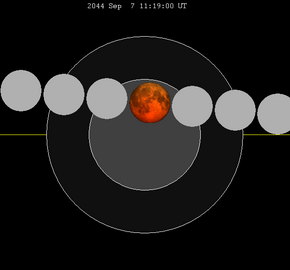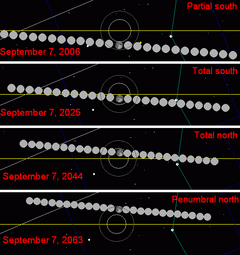| Total eclipse | |||||||||||||||||
 The Moon's hourly motion shown right to left The Moon's hourly motion shown right to left | |||||||||||||||||
| Date | September 7, 2044 | ||||||||||||||||
|---|---|---|---|---|---|---|---|---|---|---|---|---|---|---|---|---|---|
| Gamma | 0.4318 | ||||||||||||||||
| Magnitude | 1.0456 | ||||||||||||||||
| Saros cycle | 138 (30 of 82) | ||||||||||||||||
| Totality | 33 minutes, 54 seconds | ||||||||||||||||
| Partiality | 206 minutes, 12 seconds | ||||||||||||||||
| Penumbral | 344 minutes, 1 second | ||||||||||||||||
| |||||||||||||||||
| ← March 2044March 2045 → | |||||||||||||||||
A total lunar eclipse will occur at the Moon’s ascending node of orbit on Wednesday, September 7, 2044, with an umbral magnitude of 1.0456. A lunar eclipse occurs when the Moon moves into the Earth's shadow, causing the Moon to be darkened. A total lunar eclipse occurs when the Moon's near side entirely passes into the Earth's umbral shadow. Unlike a solar eclipse, which can only be viewed from a relatively small area of the world, a lunar eclipse may be viewed from anywhere on the night side of Earth. A total lunar eclipse can last up to nearly two hours, while a total solar eclipse lasts only a few minutes at any given place, because the Moon's shadow is smaller. Occurring about 5.8 days after apogee (on September 1, 2044, at 16:30 UTC), the Moon's apparent diameter will be smaller.
This lunar eclipse is the last of a tetrad, with four total lunar eclipses in series, the others being on March 25, 2043; September 19, 2043; and March 13, 2044.
This eclipse will also be the first total eclipse of Lunar Saros 138.
Visibility
The eclipse will be completely visible over eastern Australia, northeast Asia, and northwestern North America, seen rising over much of Asia and western Australia and setting over much of North and South America.
 
|
Eclipse details
Shown below is a table displaying details about this particular solar eclipse. It describes various parameters pertaining to this eclipse.
| Parameter | Value |
|---|---|
| Penumbral Magnitude | 2.08792 |
| Umbral Magnitude | 1.04756 |
| Gamma | 0.43184 |
| Sun Right Ascension | 11h06m33.5s |
| Sun Declination | +05°43'12.4" |
| Sun Semi-Diameter | 15'52.4" |
| Sun Equatorial Horizontal Parallax | 08.7" |
| Moon Right Ascension | 23h05m47.2s |
| Moon Declination | -05°21'56.9" |
| Moon Semi-Diameter | 15'15.4" |
| Moon Equatorial Horizontal Parallax | 0°55'59.6" |
| ΔT | 81.8 s |
Eclipse season
See also: Eclipse cycleThis eclipse is part of an eclipse season, a period, roughly every six months, when eclipses occur. Only two (or occasionally three) eclipse seasons occur each year, and each season lasts about 35 days and repeats just short of six months (173 days) later; thus two full eclipse seasons always occur each year. Either two or three eclipses happen each eclipse season. In the sequence below, each eclipse is separated by a fortnight.
| August 23 Descending node (new moon) |
September 7 Ascending node (full moon) |
|---|---|
 |

|
| Total solar eclipse Solar Saros 126 |
Total lunar eclipse Lunar Saros 138 |
Related eclipses
Eclipses in 2044
- An annular solar eclipse on February 28.
- A total lunar eclipse on March 13.
- A total solar eclipse on August 23.
- A total lunar eclipse on September 7.
Metonic
- Preceded by: Lunar eclipse of November 18, 2040
- Followed by: Lunar eclipse of June 26, 2048
Tzolkinex
- Preceded by: Lunar eclipse of July 27, 2037
- Followed by: Lunar eclipse of October 19, 2051
Half-Saros
- Preceded by: Solar eclipse of September 2, 2035
- Followed by: Solar eclipse of September 12, 2053
Tritos
- Preceded by: Lunar eclipse of October 8, 2033
- Followed by: Lunar eclipse of August 7, 2055
Lunar Saros 138
- Preceded by: Lunar eclipse of August 28, 2026
- Followed by: Lunar eclipse of September 18, 2062
Inex
- Preceded by: Lunar eclipse of September 28, 2015
- Followed by: Lunar eclipse of August 17, 2073
Triad
- Preceded by: Lunar eclipse of November 7, 1957
- Followed by: Lunar eclipse of July 10, 2131
Lunar eclipses of 2042–2045
| Descending node | Ascending node | |||||
|---|---|---|---|---|---|---|
| Saros | Date Viewing |
Type Chart |
Saros | Date Viewing |
Type Chart | |
| 113 | 2042 Apr 05
|
Penumbral
|
118 | 2042 Sep 29
|
Penumbral
| |
| 123 | 2043 Mar 25
|
Total
|
128 | 2043 Sep 19
|
Total
| |
| 133 | 2044 Mar 13
|
Total
|
138 | 2044 Sep 07
|
Total
| |
| 143 | 2045 Mar 03
|
Penumbral
|
148 | 2045 Aug 27
|
Penumbral
| |
| Last set | 2041 May 16 | Last set | 2042 Nov 08 | |||
| Next set | 2046 Jan 22 | Next set | 2046 Jul 18 | |||
Metonic series
The Metonic cycle repeats nearly exactly every 19 years and represents a Saros cycle plus one lunar year. Because it occurs on the same calendar date, the Earth's shadow will in nearly the same location relative to the background stars.
|
|

|
Half-Saros cycle
A lunar eclipse will be preceded and followed by solar eclipses by 9 years and 5.5 days (a half saros). This lunar eclipse is related to two total solar eclipses of Solar Saros 145.
| September 2, 2035 | September 12, 2053 |
|---|---|

|

|
See also
References
- "September 6–7, 2044 Total Lunar Eclipse (Blood Moon)". timeanddate. Retrieved 3 December 2024.
- "Moon Distances for London, United Kingdom, England". timeanddate. Retrieved 3 December 2024.
- "Total Lunar Eclipse of 2044 Sep 07" (PDF). NASA. Retrieved 3 December 2024.
- "Total Lunar Eclipse of 2044 Sep 07". EclipseWise.com. Retrieved 3 December 2024.
- Mathematical Astronomy Morsels, Jean Meeus, p.110, Chapter 18, The half-saros
External links
- 2044 Sep 07 chart: Eclipse Predictions by Fred Espenak, NASA/GSFC
This lunar eclipse-related article is a stub. You can help Misplaced Pages by expanding it. |


